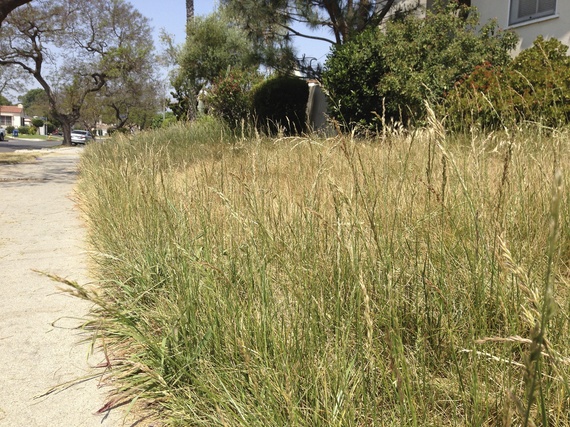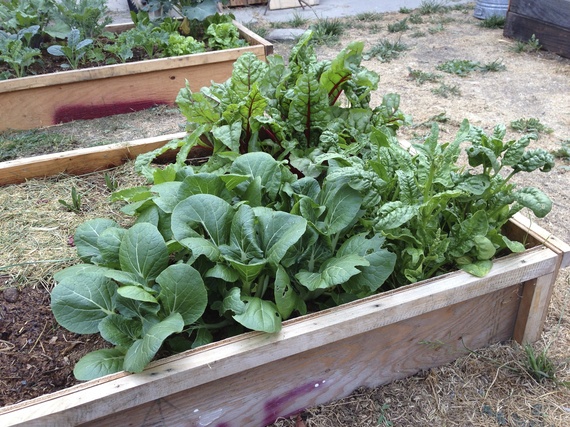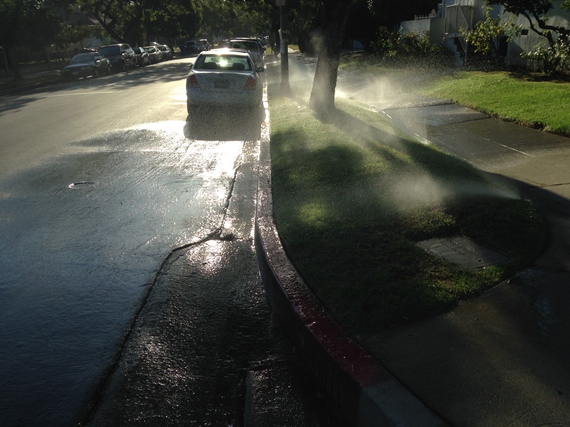Dear Neighbors,
Hello! My name is Jonathan Kim and I have been living at the house on the corner of _____ and _____ since December 2011. I had previously lived in an apartment just two blocks from my current location, and I am very glad that I decided to stay in this terrific neighborhood.
Many of you may know my house, a handsome Steinkamp, by its front lawn, which I largely stopped watering and tending close to two years ago, first allowing the grass to grow long, then mowing it and allowing weeds to grow. On several occasions, some of you (sometimes repeatedly) have asked me in person or by anonymous letter about the state of my front yard, when I will develop it into something more attractive, and when those plans will be acted on. A few of your comments have been sympathetic, some have been angry, but all have been insistent. I thought I would write this to address your concerns collectively.
First, please know that I very much sympathize with your stance. I'm sure that because of what I've allowed my front yard to become, you must think of me as a nightmare of a neighbor. I also realize that my opinions on lawns and yards (which I'll explain) are extremely difficult to sympathize with for the vast majority of Americans, including my parents. I understand that none of you are demanding that I install a water-wasting lawn, but simply that I do some form of landscaping, or at least cut the weeds and more frequently pick up the trash that gets caught in them. And I hope you believe me that all of those things are coming soon and will hopefully be completed well before the end of the year (I'll explain this later as well).
I realize that my dead, weedy front yard is a great source of annoyance for many of you that you face on a daily basis. I am truly sorry for your consternation, and I hope when my front yard is finally completed that I can win back your good will. Please believe me that I take no joy from your scorn.
However, I am willing to accept your scorn in order to do what I feel is right during this historic, extreme, and potentially long-lasting drought that has engulfed California and much of the American West. While I know that my dead, weedy lawn is far from popular, I hope you will continue reading to learn why my decision for it to be that way is not thoughtless.
A Recent History of My Lawn
As you may recall, when my house was being prepared for sale in 2011, the previous owners covered the front and back yards with fresh green turf. This was their decision, not mine. But having been convinced (like most Americans) that it was my civic duty and responsibility to have a lush, green lawn in order to maintain appearances in my neighborhood as well as interpersonal harmony with my neighbors, I decided to swallow my objections and continued the watering and landscaping regimen the previous owners had set.
I soon learned how the previous owners had kept the lawn so green -- copious amounts of expensive water on a near-daily basis. So over the past two years, I experimented with some options like reducing watering, spot watering, and going off a regular mowing schedule to allow the grass to grow longer between cuts, thus shading the ground and preserving moisture. Personally, I loved the look of this long grass, which I felt made my house in the middle of Los Angeles appear as if it was sitting in a grassy country meadow.
I know many of you did not share my views on the long grass. And I will be the first to admit that the grass eventually got longer than I wanted it to (over 3 feet high in some places) since my irregular landscaping requests complicated my working relationship with my gardener, especially since my lack of Spanish led to my having to communicate with him through a less-than-reliable English-speaking family member. However, I am happy to say that when the long grass in my front yard was finally mowed, I was able to dry and eventually use the grass in my backyard vegetable garden as mulch and to fill my planter boxes for a process called sheet mulching. This dry grass lasted me for over a year, contributing to my eventually being able to grow roughly 70% of my produce -- an accomplishment I take great pride in.
Having let the long grass drop the next season's worth of seed before it was mowed, I was eager to repeat the process and augment it with California native wildflowers from seeds I scattered before the first rain. I hoped that the winter/spring rains would be enough for another productive crop of grass.
But instead of rain, what followed in 2013-2014 was by far the driest "rainy" season I had ever experienced during my more than 30 years living in California. The rain simply, persistently did not come in a way that became truly mindboggling. The idea that Los Angeles would receive only one quarter of its average rainfall (after 2011 and 2012's well-below-average rainfalls) seemed outlandish -- almost funny -- and was made darker by our collective inability to do anything about it. Prayers for rain continue to go unanswered.
Living With Drought
I moved to California when I was three years old and have spent most of my life here in some level of drought mindset. I remember as a child my mother telling me that I would no longer be taking baths due to drought conditions and the associated rise in water prices, and I have been committed to conserving water ever since. But there was something about that virtually rainless 2013-2014 rain season that scared and shook me more deeply and profoundly than the previous two years of drought, or any other drought years in my lifetime. And the fact that some California towns are being forced to truck in water and eventually may have to be abandoned, along with recent research indicating that historical precipitation trends amplified by global warming may lead to this drought persisting for the foreseeable future as the "new normal", leaves me fearing for the state I love so much.
With this fear and the idea imprinted on my brain from childhood that a lack of resources requires changes in behavior, the decision to stop watering my lawn and leave my front yard to nature was a relatively easy one, despite the scorn I knew it would attract. But in the face of California's terrifying drought, that scorn is a consequence I'm willing to accept.
But by not watering my lawn, I learned that some plants could make do with the paltry precipitation they received. In areas that could retain more moisture due to shade from trees, a carpet of clover (an excellent soil improver) appeared with vibrant yellow flowers that bloomed in the spring. And as the weather got hotter and drier, the "weeds" (mostly dandelion and prickly lettuce) took over. "Weeds" is in quotes since, as a gardener with Master Gardener training, I am aware that there is scientifically no such thing as a weed. A "weed" is simply the name humans assign to a plant that is growing where a human does not want it to grow.
By that logic, since I take no offense to the "weeds" growing on my front yard, they are not weeds. And to be honest, I've been impressed and have come to admire these hardy plants that can flourish to such impressive heights with so little water. These are the opportunistic plants that are adapted to these conditions and help improve the soil by anchoring it and drawing nutrients from deeper in the ground so they can be accessed nearer to the surface, while creating pathways for water and organic matter to penetrate. What's more, dandelions and prickly lettuce are both edible -- the Latin name for dandelion, taraxacum officinale, actually translates to "official remedy for disorders"! Some of you may have seen me picking prickly lettuce for my morning smoothies. If those "weeds" want and are able to grow under such inhospitable conditions, sometimes up to six feet tall, I'm inclined to let them.
Waste In A Time of Scarcity
What people feel is attractive or ugly is extremely subjective and is heavily influenced by the status quo and dogmatic thinking, both of which mean little to me. As I said, I know that my stance is extremely unsympathetic and perhaps unrelatable. But to bolster my point about the subjective nature of visual attractiveness, I would like to tell you what I see when I come across a lush green lawn.
In light of the ways this historic drought is ravaging California and what global warming portends for the state's future, I believe that all of us -- as well as future generations -- will look back ruefully on the decades we've spent pouring potable water onto lawns, wasting so much of our most valuable and essential resource that it drenched our sidewalks, evaporated in the sun, or spilled into gutters so it could be emptied into the ocean. We will wonder how anyone could have thought that a green, largely useless lawn was worth so much needless suffering. I've spent enough time walking my dog through the surrounding neighborhoods to know that the overwhelming majority of lawns never have children playing on them or people sitting on them. Our most precious resource is being wasted so people can look at a green outdoor carpet.
Because of that, I can honestly say that seeing a green lawn in Los Angeles during this extreme drought fills me with anger bordering on disgust at the irresponsible and morally/environmentally indefensible wasting of our most precious and increasingly scarce resource. While I admit that there's something vaguely pleasurable about the sight of a green lawn and its inoffensive uniformity, it is frustrating and incomprehensible to me that anyone would value (debatable) aesthetics over the ability for themselves and others to continue living in Southern California with a semblance of normalcy. It's as rational to me as destroying medicine in the midst of an epidemic.
This drought we are in is no joke and is already radically altering California's environment. It's even causing parts of California to sink! As we speak, reservoirs are drying up, aquifers that feed wells are quickly being sucked dry, and groundwater is being used faster than it can be replenished. This is impacting the lives of millions of our fellow Californians, some of whom live in towns where bottled water is their only recourse. Farmers and businesses that rely on water and precipitation (skiing, boating, rentals, etc.) are laying off employees or going bankrupt, as are the ancillary businesses that rely on the tourists those activities bring (restaurants, tourist shops, hotels, etc.). I am honestly having a difficult time imagining what California will be like if these exceptional drought conditions continue for even two more years, let alone longer.
If you accept that California is enduring its worst drought in recorded history (and you should), how can you justify dumping thousands of gallons of water on a lawn every year? I am yet to hear one convincing argument for why a green lawn trumps conservation during a drought, most likely since none exist that could justify such wanton waste for something so insignificant. I would not burn food in front of starving people simply because I like the color of the flames. Besides, the existence of lawns should not be seen as a given since they are actually a vestige of mid/late-1800s thinking that believed that orderly front lawns were needed to combat the slovenliness of the American landscape, while also serving as a reaction to the walled-in estate lawns of the British. If you want to learn more about the history of lawns, I'd suggest reading Michael Pollan's excellent essay "Why Mow? The Case Against Lawns".
And it now seems that California's government agrees with my concerns, having passed new laws limiting how often and how much homeowners can water their lawns and issuing fines for violators. In my opinion, these new restrictions don't go nearly far enough, most likely due to political cowardice and fear of angering lawn-loving homeowners. I hope the state government will soon approve more stringent restrictions on water usage, including big price hikes for heavy users, but I assume this will happen in coming months as food prices rise, more towns go dry, and the effects of the drought become impossible to deny, even for city dwellers. Along with letting my lawn die, I am doing my part to conserve water in a number of ways: reusing the water I use washing produce to water my garden, turning off the water while I lather myself during showers, reducing my toilet flushes, etc. In addition, I am making use of LADWP's service for reporting violations of the new water restrictions (find out LADWP's phase 2 water restrictions and how to report water waste here).
Preparing For A Dry Future
You may have noticed that I have recently had the tall weeds in my front yard removed. I hope the lawn will remain weed-free until I can have it landscaped with drought-resistant plants, California wildflowers, and xeriscaping that will require little or no additional water once the plants are established. I have drawn up plans and am currently in consultation with a landscaping company, though delays on their end have prevented me from moving forward as quickly as I would like. However, I would like to have all of the landscaping in place to take advantage of any autumn and winter rains, with the goal of having the job completed by Thanksgiving or earlier.
I hope this answers any questions and clears up whatever concerns you may have about my front yard. And if you haven't already, I would like to strongly urge all of you who have lawns to replace them with drought-tolerant landscaping, which can be quite beautiful, is a more accurate reflection of Southern California's native flora and climate, and will support native birds and insects. And I'm sure you'll also appreciate the savings on your water bill, which will only grow if the drought continues and water prices rise.
And if you can't afford a major landscaping job right now, I'd like to strongly encourage you to simply let your lawn die. Hopefully you will find it as liberating as I did to be free of the endless, environmentally-unfriendly, money-wasting cycle of watering, mowing, seeding, and fertilizing a lawn that you have probably never even sat on. You may get some dirty looks from some neighbors (as I did), but despite what many would have you believe, your front yard is your own and you don't owe its maintenance to anyone. I don't believe that a dead lawn is a fire hazard, nor does it seem to be hampering the rise in property values.
In fact, I believe having a dead lawn during this drought should be a badge of honor, proof that you are a responsible Californian who cares about the well-being of your fellow Californians and the future of this wonderful state. If you simply can't stand the idea of a brown lawn, you can always replace your grass with astroturf or hire a company to paint your dead lawn green with environmentally-friendly paint, which is becoming an increasingly popular option.
We all must take drastic measures to reduce our water usage immediately. Otherwise, looking at a neighbor's dead, weedy lawn will be the least of your worries. It will simply be another feature of California's new normal.
Sincerely,
Jonathan Kim
(Originally posted on my blog YouShouldBeGardening.com)


